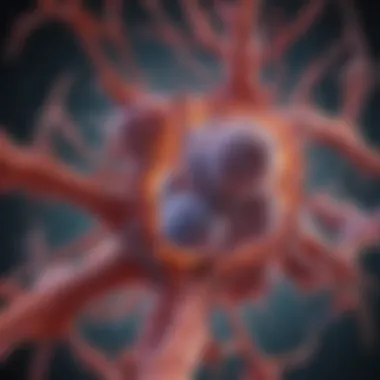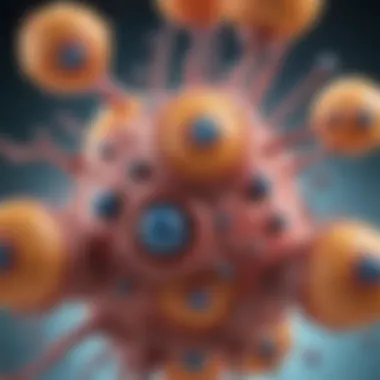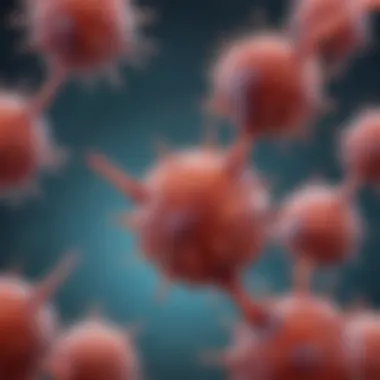Understanding HHV-6 Antibodies: Mechanisms and Research


Intro
Human Herpesvirus 6 (HHV-6) stands as a prominent member of the herpes virus family, known for its intricate interactions with the human immune system. The two variants, HHV-6A and HHV-6B, are of particular interest in virology and immunology. This article delves into the antibodies produced in response to HHV-6, their mechanisms, and the implications for broader health contexts. Understanding these antibodies is critical, as they reveal insights into immune responses and the potential for therapeutic advancements.
The exploration of HHV-6 antibodies entails an investigation into their production, function, and the role they play in human health and disease. This includes a review of recent research and current methodologies utilized in studying these antibodies. As antibody responses can significantly differ among individuals and situations, a thorough understanding is necessary for both clinical and research settings.
As we move forward, we will investigate the detailed mechanisms behind HHV-6 antibodies, the implications of their presence or absence, and recent advancements in research related to this virus. We aim to provide a well-rounded perspective that caters to students, researchers, educators, and professionals who seek depth in this complex field.
Prelude to Human Herpesvirus
Human Herpesvirus 6 (HHV-6) is a significant viral entity within the herpesvirus family. Understanding HHV-6 is crucial due to its prevalent role in various clinical conditions, especially in immunocompromised individuals and in pediatric populations. This introduction sets the stage for the subsequent analysis of HHV-6 antibodies by highlighting its biological characteristics and immunological implications.
The study of HHV-6 reveals complex mechanisms through which the virus interacts with the host's immune system. It underscores the importance of antibodies in defending against viral infections. Therefore, a clear comprehension of HHV-6 also informs medical professionals and researchers about potential therapeutic targets and vaccination strategies that are currently being studied.
Overview of Herpesviruses
Herpesviruses are a large family of DNA viruses known for their capacity to establish lifelong infections in their hosts. The family comprises at least eight known human herpesviruses, including HHV-1 (Herpes Simplex Virus 1) and HHV-2 (Herpes Simplex Virus 2). These viruses share common structural features, such as their spherical shape and double-stranded DNA. While some herpesviruses are well-understood, others, like HHV-6, present intricate challenges in terms of classification and pathology.
The biological diversity of herpesviruses necessitates ongoing research to fully elucidate their mechanisms of action and interaction with immune responses. This knowledge is vital for developing effective interventions against related diseases.
Classification of HHV-6
HHV-6 has two distinct variants, known as HHV-6A and HHV-6B. Both variants belong to the Betaherpesvirinae subfamily, but they exhibit different biological behaviors and clinical implications.
- HHV-6A is often associated with neurological disorders and is recognized as more pathogenic in laboratory settings.
- HHV-6B, on the other hand, is primarily linked to roseola in children, a common viral infection characterized by high fever and rash.
These classifications not only help in understanding the virus's behavior but also in developing targeted diagnosis and treatment protocols.
Epidemiology and Prevalence
Epidemiologically, HHV-6 is widespread. Serological studies indicate that by age two, the majority of children have been infected with HHV-6B, with less than 1% experiencing severe disease. The prevalence of HHV-6A in immunocompetent individuals appears to be lower, but it poses significant risks for immunocompromised patients, leading to complications like encephalitis.
The global impact of HHV-6 is relevant for both public health initiatives and individual patient management. Understanding its prevalence and the demographics of infection lays a foundation for evaluating the immune responses it elicits, especially concerning antibody production. Such insights are invaluable for furthering research on HHV-6 antibodies.
Biological Characteristics of HHV-6
The understanding of Biological Characteristics of HHV-6 is crucial in comprehending its role within the human immune system and the subsequent formation of antibodies. This section delves into key aspects like the structure of the virus, how it spreads, and how it reproduces within human cells. These details help unravel the complexities of the immune response and the development of HHV-6 antibodies, which are vital for both diagnosis and therapeutic approaches.
Virion Structure and Genetics
HHV-6 is classified into two distinct variants: HHV-6A and HHV-6B. The structure of the virion showcases an enveloped, spherical silhouette typical of herpesviruses. This envelope consists of a lipid bilayer derived from the host cell membrane, embedding glycoprotein spikes that are essential for host cell attachment. The genetic material comprises double-stranded DNA, which usually contains approximately 125 kilobases.
Understanding the genetics also sheds light on the way the virus interacts with host cells. Specific genes play pivotal roles in its life cycle, since they contribute to both replication and immune evasion. gB and gH glycoproteins facilitate entry into the hosts’ cells, presenting potential targets for therapeutic strategies.
Modes of Transmission
HHV-6 is primarily transmitted through saliva, which makes it prevalent among young children. Sharing utensils, kissing, or close contact can contribute to the spread of the virus. It can also be transmitted through other bodily fluids but to a lesser extent.
The understanding of these transmission modes is critical. Knowledge about how HHV-6 is spread can aid in formulating public health strategies and inform potential vaccination efforts. Since the virus remains latent in the body post-infection, reactivation can occur, often triggered by immunosuppression or other stressors, showcasing the necessity of robust immunity.
Replication Cycle
The replication cycle of HHV-6 follows the typical pattern observed in herpesviruses, encompassing several key phases: adsorption, penetration, uncoating, replication, assembly, and release.


- Adsorption: The virus binds to specific receptors on the surface of susceptible cells, primarily in the oral mucosa and nasopharynx.
- Penetration: The viral envelope fuses with the host cell membrane, allowing the virus's nucleocapsid to enter the cell.
- Uncoating: The viral DNA is released into the nucleus of the host cell, where it circumvents host cell defenses.
- Replication: The host cell machinery is hijacked to synthesize viral genomes and proteins.
- Assembly: Newly formed virions are assembled in the cytoplasm.
- Release: Progeny virions are released from the host cell, usually by exocytosis, enabling further infection.
This detailed understanding of the replication cycle underlines the intricacies of how HHV-6 persists and why some individuals may generate antibodies against it. It also highlights potential points of intervention for therapeutic methods aiming to mitigate the viral replication process.
"Understanding the biological characteristics of HHV-6 enhances our approach to managing infections and designing targeted therapies."
In summary, the biological properties of HHV-6, including its structure, modes of transmission, and replication processes, form the backbone of current research. A comprehensive grasp of these attributes is indispensable for devising effective strategies aimed at mitigating the impact of this virus on public health.
Immune Response to HHV-6
The immune response to Human Herpesvirus 6 (HHV-6) represents a crucial aspect of understanding the virus's impact on human health. This section highlights the complexity of the immune system's interaction with HHV-6. Recognizing these dynamics is essential for developing effective diagnostic and therapeutic strategies. Understanding how the body recognizes this virus enables researchers to explore potential interventions and manage associated diseases.
Nature of Immune Response
HHV-6 can elicit a multifaceted immune response. This response begins with innate immunity, where cells such as dendritic cells and macrophages identify and react to the virus. Cytokines are integral to this phase, as they help orchestrate the body's response and promote the development of adaptive immunity.
Adaptive immunity follows, involving T and B cells that specifically target HHV-6. CD4+ T helper cells stimulate B cells to produce antibodies, while CD8+ cytotoxic T cells play a role in killing infected cells. This dual action is vital in controlling the infection. The balance between these immune components can influence the outcome of HHV-6 infections, contributing to either resolution or the potential for chronic disease.
Role of Antibodies
Antibodies are vital for containment and eradication of HHV-6. Once produced, these proteins can neutralize the virus, preventing it from infecting host cells. Antibodies also facilitate opsonization, enhancing phagocytosis by immune cells.
There is evidence suggesting that the presence of specific antibodies can modulate the severity of clinical manifestations associated with HHV-6. In patients with a robust antibody response, symptoms may be less severe. Conversely, inadequate antibody production can lead to more severe outcomes. Understanding this relationship underscores the importance of further research into antibody production and function in HHV-6 infections.
Types of HHV-6 Antibodies
HHV-6 antibodies can be categorized into several types based on their target and timing of production:
- IgM antibodies: Typically indicate recent infection. They emerge early in infection and can provide insight into acute stages of disease.
- IgG antibodies: Indicate past infection. Their presence suggests prior exposure to the virus, contributing to immunity in the long term.
- IgA antibodies: Primarily found in mucosal areas. They are important for local immune defense and often respond to viral replication in saliva or other secretions.
The inherent variability in these antibody responses can inform clinical approaches. For example, understanding which types of antibodies are present can guide decisions in diagnosing HHV-6 related diseases or monitoring recovery from infection.
"A thorough understanding of the immune response, especially antibody types, is crucial for managing and treating HHV-6 infections effectively."
The clinical significance of these antibodies extends beyond simply monitoring infection; they may also provide avenues for therapeutic intervention and vaccine development. The ongoing research into the immune response against HHV-6 echoes the need for more extensive studies that could yield insights into its pathogenesis and influence treatment options.
Clinical Significance of HHV-6 Antibodies
Understanding the clinical significance of Human Herpesvirus 6 (HHV-6) antibodies is essential for several reasons. These antibodies play a critical role in diagnosing infections, guiding treatment decisions, and understanding the broader implications of HHV-6 on both pediatric and adult populations. As HHV-6 can influence various inflammatory and immunological conditions, recognizing the antibody response can lead to improved patient outcomes and enhanced therapeutic strategies.
Diagnosis of HHV-6 Infections
Diagnosing HHV-6 infections often involves the detection of specific antibodies in patient samples. The presence of HHV-6 antibodies can indicate prior exposure or an active infection. There are two primary types of antibodies measured: IgM and IgG. IgM antibodies indicate a recent infection, while IgG antibodies suggest a past infection. Accurate detection plays a crucial part in not just confirming HHV-6 but also in differentiating it from other herpesviruses.
The timely diagnosis of HHV-6 is vital, especially in immunocompromised patients, as it can lead to serious complications or misdiagnoses.
Typically, clinicians may use serological tests including enzyme-linked immunosorbent assays (ELISA) or Western blot analyses to detect these antibodies. These tests should be carefully interpreted alongside clinical symptoms and other laboratory findings to ensure a comprehensive assessment of the patient’s condition.
Antibody Testing Methods
Antibody testing methods have evolved over the years, enabling more sensitive and specific detection of HHV-6 antibodies. The most common methods include:
- Enzyme Immunoassay (EIA): This method measures the concentration of antibodies in serum, indicating the immune response towards HHV-6.
- Western Blot: This is employed for confirmation of results when EIA shows a positive or ambiguous result.
- PCR Techniques: Though mainly used for viral DNA detection, PCR can also indirectly inform about antibody presence by correlating with the timing and strength of the immune response.


These techniques expand the available toolbox for clinicians, improving the ability to track the progression of HHV-6-related diseases and guiding possible interventions.
Seroprevalence Studies
Seroprevalence studies are essential for understanding how widespread HHV-6 is in different populations. Research indicates that seroprevalence can vary significantly based on geographical, demographic, and age-related factors. Several studies indicate that measurably higher rates of HHV-6 antibodies are found in children compared to adults. This suggests that initial infections commonly occur in early life, and many adults remain seropositive further into their lives.
Understanding seroprevalence helps researchers and medical practitioners:
- Identify at-risk populations.
- Evaluate the potential impact of HHV-6 on public health.
- Develop better treatment and prevention strategies.
These insights inform clinical practices and public health policies, ensuring tailored strategies in managing HHV-6 effectively across different demographic sectors.
HHV-6 and Associated Diseases
Human Herpesvirus 6 (HHV-6) plays a significant role in a variety of diseases affecting both pediatric and adult populations. The understanding of how HHV-6 contributes to these diseases is critical for developing effective treatment and prevention strategies. This section will delve into the clinical implications of HHV-6, as well as the associated diseases that arise from it.
Impact on Pediatric Patients
HHV-6 is famously known for causing roseola, a common childhood illness. Up to 90% of children may be infected by the age of 2. Symptoms usually include a sudden high fever followed by a distinctive rash. While roseola is often mild, there are instances where HHV-6 is linked to more severe complications.
In some cases, the virus can lead to febrile seizures, especially in infants. Ongoing research suggests a potential connection between HHV-6 and neurological disorders. Children with weakened immune systems or those undergoing organ transplants may be at higher risk for severe manifestations of HHV-6 infection. Addressing the challenges of HHV-6 in this patient population requires awareness, early diagnosis, and timely intervention.
Involvement in Adult Diseases
HHV-6 is not limited to the childhood population; it increasingly appears to be linked with several adult diseases as well. Research indicates an association between HHV-6 and multiple sclerosis (MS). Studies show HHV-6 DNA in the central nervous system of patients with MS. Furthermore, there is growing evidence that HHV-6 may impact conditions like chronic fatigue syndrome and various autoimmune disorders.
Clinical awareness of HHV-6's potential role in adult diseases is necessary for accurate diagnosis and treatment. It is essential for healthcare providers to consider HHV-6 as a potential contributor in older populations experiencing unexplained symptoms, thus improving patient care in this area.
HHV-6 and Immune Disorders
The relationship between HHV-6 and immune disorders is another important area of study. HHV-6 can affect the immune system in various ways, leading to dysregulation. Individuals with autoimmune diseases like systemic lupus erythematosus (SLE) and rheumatoid arthritis may see exacerbation of symptoms linked to HHV-6 reactivation.
Moreover, some studies suggest that HHV-6 may be involved in the pathogenesis of some primary immunodeficiencies. The virus's ability to integrate into the host genome may form part of a complex interaction between viral infection and the immune system. Understanding this interaction can guide therapeutic approaches, offering hope to those with such disorders.
In summary, HHV-6 has far-reaching effects on both children and adults, impacting a wide range of diseases. Clinical implications of HHV-6 infection necessitate careful consideration in diverse patient groups.
Awareness of the potential complications associated with HHV-6 improves diagnosis and treatment pathways, highlighting the need for continual research and education in this area.
Recent Research Advances
The realm of research surrounding Human Herpesvirus 6 (HHV-6) antibodies has undergone significant evolution in recent years. Understanding these advances is vital, as they form the backbone of new therapeutic strategies and diagnostic tools. Researchers are actively exploring various modalities that leverage the unique immune responses elicited by HHV-6, refining both treatment and prevention approaches.
Emerging Therapeutic Approaches
Recent studies have focused on innovative therapeutic strategies aimed at modulating the immune response to HHV-6. One promising area involves the use of antiviral agents like Ganciclovir, which have shown efficacy in managing HHV-6 associated conditions, particularly in immunocompromised individuals. Clinical studies are exploring the implications of using these antivirals to reduce viral loads and improve patient outcomes.
Additionally, monoclonal antibodies are emerging as a possible treatment avenue. Research highlights that these antibodies can specifically target HHV-6 proteins, thus neutralizing the virus and potentially limiting its spread in the body. Clinical trials are currently in progress to evaluate their safety and efficacy, demonstrating a critical shift towards more targeted therapeutic approaches.
Vaccination Efforts
The search for an effective vaccine against HHV-6 is ongoing. Researchers are exploring various vaccine platforms, including live attenuated and subunit vaccines. These efforts are primarily driven by the need to prevent central nervous system disorders associated with HHV-6, particularly in pediatric populations.
Preliminary studies indicate that vaccination may boost the immune response to HHV-6, thereby reducing the incidence of infection and subsequent complications. The development of a successful vaccine against HHV-6 could have a profound impact on public health, especially considering the virus's prevalence in the general population.


Future Research Directions
Future research points towards several avenues that could enhance our understanding of HHV-6 antibodies and their role in various conditions. One key area is the exploration of the long-term effects of HHV-6 infection on immune system function. Investigating how antibodies evolve over time and their interaction with other pathogens could provide valuable insights into chronic health issues associated with HHV-6.
Another aspect is the need for standardized methods of measuring HHV-6 antibodies. Establishing clear protocols could enable more robust comparisons across studies, contributing to a more unified understanding of HHV-6 pathology.
Moreover, the development of computational models to predict the immune response to HHV-6 could pave the way for personalized medicine approaches that customize treatment based on an individual’s immune profile.
In summary, recent research advances in HHV-6 not only enhance our understanding of the virus and its antibodies but also open new pathways for clinical interventions and preventive strategies.
Challenges in HHV-6 Antibody Studies
The complexities surrounding HHV-6 antibodies are profound, affecting both research and clinical practice. Remote from the straightforward assessment of typical infections, HHV-6 presents multiple challenges that require attention. Understanding these obstacles is essential for advancing our knowledge of the virus and the role antibodies play in immune response, diagnostics, and treatment.
Several key elements contribute to this challenging landscape, impacting the development of reliable biomarkers and the implementation of effective therapies.
Variability in Antibody Response
Variability in antibody response signals a significant challenge for researchers exploring HHV-6. Not all individuals respond uniformly to HHV-6 infection. Factors such as age, immunocompetence, genetics, and co-infections can influence antibody production. Some individuals may produce robust antibodies, while others may have a diminished response or none at all. This variability complicates the interpretation of studies, as it introduces a level of unpredictability that can skew results.
Furthermore, different strains of HHV-6, namely HHV-6A and HHV-6B, may elicit varying antibody responses. Thus, identifying which type of antibody corresponds with specific clinical outcomes remains an ongoing question within the field. Researchers must account for these variations in their analyses to gain a clearer understanding of the immune landscape in relation to HHV-6.
Limitations of Current Methods
Current methodologies in studying HHV-6 antibodies also present certain limitations. Many antibody tests lack standardization, making comparisons between studies problematic. The quality and type of assays used—such as ELISA or Western blot—can all yield different sensitivity and specificity results. This inconsistency leads to discrepancies in seroprevalence data and may affect the overall assessment of HHV-6's prevalence in different populations.
Moreover, some diagnostic approaches may fail to detect antibodies in patients during the acute phase of the infection. The timing of sample collection can dramatically influence the detection rates. In many cases, the acute immune response can be missed, leaving critical gaps in understanding the overall immune dynamics in HHV-6 infections.
These limitations necessitate the development of better assays and standardized protocols that can enhance the accuracy and reliability of antibody detection.
Identification of Follow-Up Studies
The identification of follow-up studies is crucial for enriching our understanding of HHV-6 antibodies and their long-term implications. As research continues to evolve, it is important to establish comprehensive longitudinal studies to monitor antibody responses over time. This can help elucidate the correlation between antibody levels and clinical manifestations of HHV-6-related diseases.
Additionally, understanding the chronicity of HHV-6 infections through follow-up studies may reveal long-term impacts on immune health. Individuals who may have been exposed to HHV-6 in early life might sustain immunological consequences into adulthood. Thus, continued research that addresses these long-term effects will be necessary to advance our grasp of the significance of HHV-6 antibodies.
In summary, the challenges inherent in HHV-6 antibody studies are multifaceted. Addressing these challenges will be critical in furthering knowledge about the virus, improving diagnostics, and developing effective therapeutic strategies.
Ending
The conclusion provides a critical opportunity to synthesize the details discussed throughout the article. Understanding HHV-6 antibodies is imperative for both the medical community and researchers in virology. The intricate relationship between these antibodies and the immune system has extensive implications for diagnosis, treatment strategies, and the ongoing research landscape.
Key points from this article include the classification of HHV-6, the immune response it elicits, and the evolving methods of antibody testing. Each of these elements contributes to a larger understanding of how HHV-6 can influence health outcomes, particularly in vulnerable populations.
Reflecting on the findings emphasizes the importance of recognizing the complexities of the immune response to HHV-6. Through serological testing and immune profiling, health practitioners can gauge the status of an individual's infection and the potential risk factors associated with complications. These insights allow for more tailored patient management plans.
Moreover, continuous research is paramount. Studies exploring the dynamics of HHV-6 antibodies will not only advance our understanding of this virus but will also pave the way for improved therapeutic approaches, possibly leading to the development of vaccines.
Summary of Findings
In summary, key findings from this article highlight the multifaceted role of HHV-6 antibodies. These findings encapsulate:
- The essential role of HHV-6 antibodies in mediating the immune response during viral infections.
- The importance of accurate diagnostic methods to detect these antibodies, which can indicate both current and past infections.
- The correlation between seroprevalence studies and the epidemiology of HHV-6, showcasing its widespread impact on public health.
- Ongoing advancements in therapeutic strategies and potential vaccine development, which hinge upon a better understanding of the specific antibody responses.
Final Thoughts
Ultimately, the study of HHV-6 antibodies remains a critical field with implications reaching far beyond basic science. As our comprehension of this virus evolves, so too will the strategies required to manage its effects on individuals and populations. The quest for deeper insights continues through research, which aims not only to understand the biological mechanisms at play but also to develop interventions that can address the challenges posed by HHV-6 infection.
"The importance of HHV-6 antibody research cannot be overstated; it serves as a gateway to understanding broader immunological responses that could enhance our approach to various health conditions."
For students, researchers, and healthcare professionals alike, engaging with this topic will enrich their perspective on virology and immunology, emphasizing the necessity for ongoing education in this rapidly changing field.







